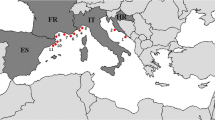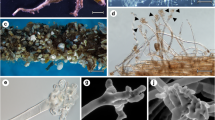Abstract
Roots of terrestrial plants host a wide spectrum of soil fungi that form various parasitic, neutral and mutualistic associations. A similar trend is evident in freshwater aquatic plants and plants inhabiting salt marshes or mangroves. Marine vascular plants (seagrasses), by contrast, seem to lack specific root–fungus symbioses. We examined roots of two Mediterranean seagrasses, Posidonia oceanica and Cymodocea nodosa, in the northwestern Mediterranean Sea for fungal colonization using light and scanning and transmission electron microscopy. We found that P. oceanica, but not C. nodosa, is regularly associated with melanized septate hyphae in a manner resembling colonization by the ubiquitous dark septate endophytes (DSE) in roots of most terrestrial plants. P. oceanica roots were found to be colonized by sparse dematiaceous running hyphae as well as dense parenchymatous nets/hyphal sheaths on the root surface, intracellular melanized microsclerotia and occasionally also intra- and intercellular hyphae. The colonization was most prominent in the thick-walled hypodermis of the thinnest healthy looking roots, and the mycobiont seemed to colonize both living and dead host cells. Dark septate hyphae infrequently occurred also inside rhizodermal cells, but never colonized vascular tissues. The biological significance of this overlooked marine symbiosis remains unknown, but its morphology, extent, distribution across the NW Mediterranean Sea and absence in C. nodosa indicate an intriguing relationship between the dominant Mediterranean seagrass and its dark septate root mycobionts.





Similar content being viewed by others
References
Addy HD, Piercey MM, Currah RS (2005) Microfungal endophytes in roots. Can J Bot 83:1–13
Arnaud-Haond S, Duarte CM, Diaz-Almela E, Marbá N, Sintes T et al (2012) Implications of extreme life span in clonal organisms: millenary clones in meadows of the threatened seagrass Posidonia oceanica. PLoS ONE 7, e30454. doi:10.1371/journal.pone.0030454
Beck-Nielsen D, Madsen TV (2001) Occurrence of vesicular-arbuscular mycorrhiza in aquatic macrophytes from lakes and streams. Aquat Bot 71:141–148
Brundrett MC (2002) Coevolution of roots and mycorrhizas of land plants. New Phytol 154:275–304
Brundrett MC (2004) Diversity and classification of mycorrhizal associations. Biol Rev 79:473–495
Brundrett MC (2009) Mycorrhizal associations and other means of nutrition of vascular plants: understanding the global diversity of host plants by resolving conflicting information and developing reliable means of diagnosis. Plant Soil 320:37–77
Cuomo V, Vanzanella F, Fresi E, Cinelli F, Mazzella L (1985) Fungal flora of Posidonia oceanica and its ecological significance. Trans Br Mycol Soc 84:35–40
Danielson RM, Visser S (1990) The mycorrhizal and nodulation status of container-grown trees and shrubs reared in commercial nurseries. Can J For Res 20:609–614
den Hartog C (1970) Seagrasses of the world. North-Holland Publishing, Amsterdam
den Hartog C, Kuo J (2007) Taxonomy and biogeography of seagrasses. In: Larkum AWD, Orth RJ, Duarte CM (eds) Seagrasses: biology, ecology and conservation. Springer, Dordrecht
Deshmukh S, Hückelhoven R, Schäfer P, Imani J, Sharma M, Weiss M, Waller F, Kogel K-H (2006) The root endophytic fungus Piriformospora indica requires host cell death for proliferation during mutualistic symbiosis with barley. Proc Natl Acad Sci U S A 103:18450–18457
Eberl R (2011) Mycorrhizal association with native and invasive cordgrass Spartina spp. in San Francisco Bay, California. Aquat Biol 14:1–7
Fernando AA, Currah RS (1996) A comparative study of the effects of the root endophytes Leptodontidium orchidicola and Phialocephala fortinii (Fungi Imperfecti) on the growth of some subalpine plants in culture. Can J Bot 74:1071–1078
Fourqurean JW, Duarte CM, Kennedy H, Marba N, Holmer M et al (2012) Seagrass ecosystems as a globally significant carbon stock. Nat Geosci 5:505–509
García-Martínez M, Kuo J, Kilminster K, Walker D, Rossello-Mora R et al (2005) Microbial colonization in the seagrass Posidonia spp. roots. Mar Biol Res 1:388–395
Gilroy S, Jones DL (2000) Through form to function: root hair development and nutrient uptake. Trends Plant Sci 5:56–60
Green EP, Short FT (2003) World atlas of seagrasses. University of California Press, Berkeley
Grünig C, Queloz V, Sieber T, Holdenrieder O (2008) Dark septate endophytes (DSE) of the Phialocephala fortinii s. l.—Acephala applanata species complex in tree roots: classification, population biology, and ecology. Botany 86:1355–1369
Hemminga MA, Duarte CM (2000) Seagrass ecology. Cambridge University Press, Cambridge
Khan AG, Belik M (1995) Occurrence and ecological significance of mycorrhizal symbiosis in aquatic plants. In: Varma A, Hock B (eds) Mycorrhiza. Springer, Berlin
Kohout P, Sýkorová Z, Čtvrtlíková M, Rydlová J, Suda J et al (2012) Surprising spectra of root-associated fungi in submerged aquatic plants. FEMS Microbiol Ecol 80:216–235
Kothamasi D, Kothamasi S, Bhattacharyya A, Kuhad RC, Babu CR (2006) Arbuscular mycorrhizae and phosphate solubilising bacteria of the rhizosphere of the mangrove ecosystem of Great Nicobar island, India. Biol Fertil Soils 42:358–361
Kuo J, den Hartog C (2007) Seagrass morphology, anatomy and ultrastructure. In: Larkum AWD, Orth RJ, Duarte CM (eds) Seagrasses: biology, ecology and conservation. Springer, Dordrecht
Kuo J, McComb AJ (1989) Seagrass taxonomy, structure and development. In: Larkum AWD, McComb AJ, Shepherd SA (eds) Biology of seagrasses. Elsevier, Amsterdam
Kuo J, McComb AJ (1998) Cymodoceaceae. In: Kubitzki K (ed) The families and genera of vascular plants: Flowering Plants - Monocotyledons. Springer, Berlin, Heidelberg
Kuo J, McComb AJ, Cambridge ML (1981) Ultrastructure of the seagrass rhizosphere. New Phytol 89:139–143
Les DH, Cleland MA, Waycott M (1997) Phylogenetic studies in Alismatidae, II: evolution of marine angiosperms (seagrasses) and hydrophily. Syst Bot 22:443–463
Lukešová T, Kohout P, Větrovský T, Vohník M (2015) The potential of Dark Septate Endophytes to form root symbioses with ectomycorrhizal and ericoid mycorrhizal middle European forest plants. PLoS ONE 10, e0124752. doi:10.1371/journal.pone.0124752
Münzenberger B, Bubner B, Wöllecke J, Sieber TN, Bauer R et al (2009) The ectomycorrhizal morphotype Pinirhiza sclerotia is formed by Acephala macrosclerotiorum sp nov., a close relative of Phialocephala fortinii. Mycorrhiza 19:481–492
Nielsen SL, Thingstrup I, Wigand C (1999) Apparent lack of vesicular-arbuscular mycorrhiza (VAM) in the seagrasses Zostera marina L. and Thalassia testudinum Banks ex Konig. Aquat Bot 63:261–266
O’Dell TE, Massicotte HB, Trappe JM (1993) Root colonization of Lupinus latifolius Agardh. and Pinus contorta Dougl. by Phialocephala fortinii Wang & Wilcox. New Phytol 124:93–100
Panno L, Bruno M, Voyron S, Anastasi A, Gnavi G et al (2013) Diversity, ecological role and potential biotechnological applications of marine fungi associated to the seagrass Posidonia oceanica. N Biotechnol 30:685–694
Peterson CA (1989) Significance of the exodermis in root function. In: Loughman BC, Gašparíková O, Kolek J (eds) Structural and functional aspects of transport in roots. Developments in Plant and Soil Sciences 36:35–40. Springer
Peterson RL, Massicotte HB (2004) Exploring structural definitions of mycorrhizas, with emphasis on nutrient-exchange interfaces. Can J Bot 82:1074–1088
Peterson RL, Wagg C, Pautler M (2008) Associations between microfungal endophytes and roots: do structural features indicate function? Botany 86:445–456
Radhika KP, Rodrigues BF (2007) Arbuscular mycorrhizae in association with aquatic and marshy plant species in Goa, India. Aquat Bot 86:291–294
Read DJ (1991) Mycorrhizas in ecosystems. Experientia 47:376–391
Read DJ, Perez-Moreno J (2003) Mycorrhizas and nutrient cycling in ecosystems—a journey towards relevance? New Phytol 157:475–492
Read DJ, Leake JR, Perez-Moreno J (2004) Mycorrhizal fungi as drivers of ecosystem processes in heathland and boreal forest biomes. Can J Bot 82:1243–1263
Redecker D, Kodner R, Graham LE (2000) Glomalean fungi from the Ordovician. Science 289:1920–1921
Schreiber L, Hartmann K, Skrabs M, Zeier J (1999) Apoplastic barriers in roots: chemical composition of endodermal and hypodermal cell walls. J Exp Bot 50:1267–1280
Selosse MA, Le Tacon F (1998) The land flora: a phototroph-fungus partnership? Trends Ecol Evol 13:15–20
Sengupta A, Chaudhuri S (2002) Arbuscular mycorrhizal relations of mangrove plant community at the Ganges river estuary in India. Mycorrhiza 12:169–174
Sieber TN (2002) Fungal root endophytes. In: Waisel Y, Eshel A, Kafkafi I (eds) Plant roots—the hidden half, 3rd edn. Marcel Dekker, New York
Smith SE, Read DJ (2008) Mycorrhizal symbiosis. Academic, London
Søndergaard M, Laegaard S (1977) Vesicular-arbuscular mycorrhiza in some aquatic vascular plants. Nature 268:232–233
Sudová R, Rydlová J, Čtvrtlíková M, Havránek P, Adamec L (2011) The incidence of arbuscular mycorrhiza in two submerged Isoetes species. Aquat Bot 94:183–187
Tejesvi MV, Sauvola T, Pirttilä AM, Ruotsalainen AL (2013) Neighboring Deschampsia flexuosa and Trientalis europaea harbor contrasting root fungal endophytic communities. Mycorrhiza 23:1–10
Torta L, Lo Piccolo S, Piazza G, Burruano S, Colombo P et al (2014) Lulwoana sp., a dark septate endophyte in roots of Posidonia oceanica (L.) Delile seagrass. Plant Biol (Stuttg) 17:505–511
Usuki F, Narisawa K (2007) A mutualistic symbiosis between a dark septate endophytic fungus, Heteroconium chaetospira, and a nonmycorrhizal plant, Chinese cabbage. Mycologia 99:175–184
Vohník M, Albrechtová J (2011) The co-occurrence and morphological continuum between ericoid mycorrhiza and dark septate endophytes in roots of six European Rhododendron species. Folia Geobot 46:373–386
Vohník M, Lukančič S, Bahor E, Regvar M, Vosátka M et al (2003) Inoculation of Rhododendron cv. Belle-Heller with two strains of Phialocephala fortinii in two different substrates. Folia Geobot 38:191–200
Welsh AK, Burke DJ, Hamerlynck EP, Hahn D (2010) Seasonal analyses of arbuscular mycorrhizae, nitrogen-fixing bacteria and growth performance of the salt marsh grass Spartina patens. Plant Soil 330:251–266
Wurzburger N, Bledsoe CS (2001) Comparison of ericoid and ectomycorrhizal colonization and ectomycorrhizal morphotypes in mixed conifer and pygmy forests on the northern California coast. Can J Bot 79:1202–1210
Yu T, Nassuth A, Peterson RL (2001) Characterization of the interaction between the dark septate fungus Phialocephala fortinii and Asparagus officinalis roots. Can J Microbiol 47:741–753
Acknowledgments
Financial support was provided by the Czech Science Foundation (GACR P504/10/0781) and the Grant Agency of Charles University in Prague (GAUK 68313/PrF/B-BIO). This study is a part of the long-term research projects of the Institute of Botany ASCR (RVO 67985939) and Faculty of Science, Charles University in Prague (MŠMT LO1417). Lukáš Kalous organized a workshop on marine biology in Borak, Croatia which substantially stimulated our research at its beginning, Kateřina Rylková helped with collection and processing of some Croatian root samples and Jiří Machač took SEM microphotographs and assembled the figures; all these contributions are greatly acknowledged. In Croatia, root samples were collected in accordance with a permit issued by the Croatian Ministry of Environmental and Nature Protection (Klasa UP/I-612-07/13-48/48, Urbroj 517-07-1-1-1-13-2).
Author information
Authors and Affiliations
Corresponding author
Rights and permissions
About this article
Cite this article
Vohník, M., Borovec, O., Župan, I. et al. Anatomically and morphologically unique dark septate endophytic association in the roots of the Mediterranean endemic seagrass Posidonia oceanica . Mycorrhiza 25, 663–672 (2015). https://doi.org/10.1007/s00572-015-0642-7
Received:
Accepted:
Published:
Issue Date:
DOI: https://doi.org/10.1007/s00572-015-0642-7




